Equality Act 2010: Rights and Protections for Mothers and Employers
VerifiedAdded on 2020/12/29
|11
|2628
|232
Essay
AI Summary
This essay provides a critical evaluation of the Equality Act 2010, focusing on its provisions and effectiveness in protecting mothers and prospective mothers in the workplace. It examines various forms of discrimination, including direct and indirect discrimination, harassment, and victimisation, highlighting the legal framework established to safeguard individuals' rights. The essay discusses the findings of government reports and research, such as the Business, Innovation and Skills (BIS) and the Equality and Human Rights Commission (EHRC) report, which reveal the prevalence of discriminatory practices against pregnant women and mothers. It outlines the actions taken by the EHRC and the government, including recommendations and responses related to risk assessments, antenatal care, and the provision of information to employees. The essay also explores the implications of the Equality Act 2010 for employers and employed staff, offering recommendations for employers to foster a fair and supportive workplace environment. The conclusion emphasizes the ongoing challenges and the importance of continued efforts to eliminate discrimination and ensure equal opportunities for mothers and prospective mothers in the UK.
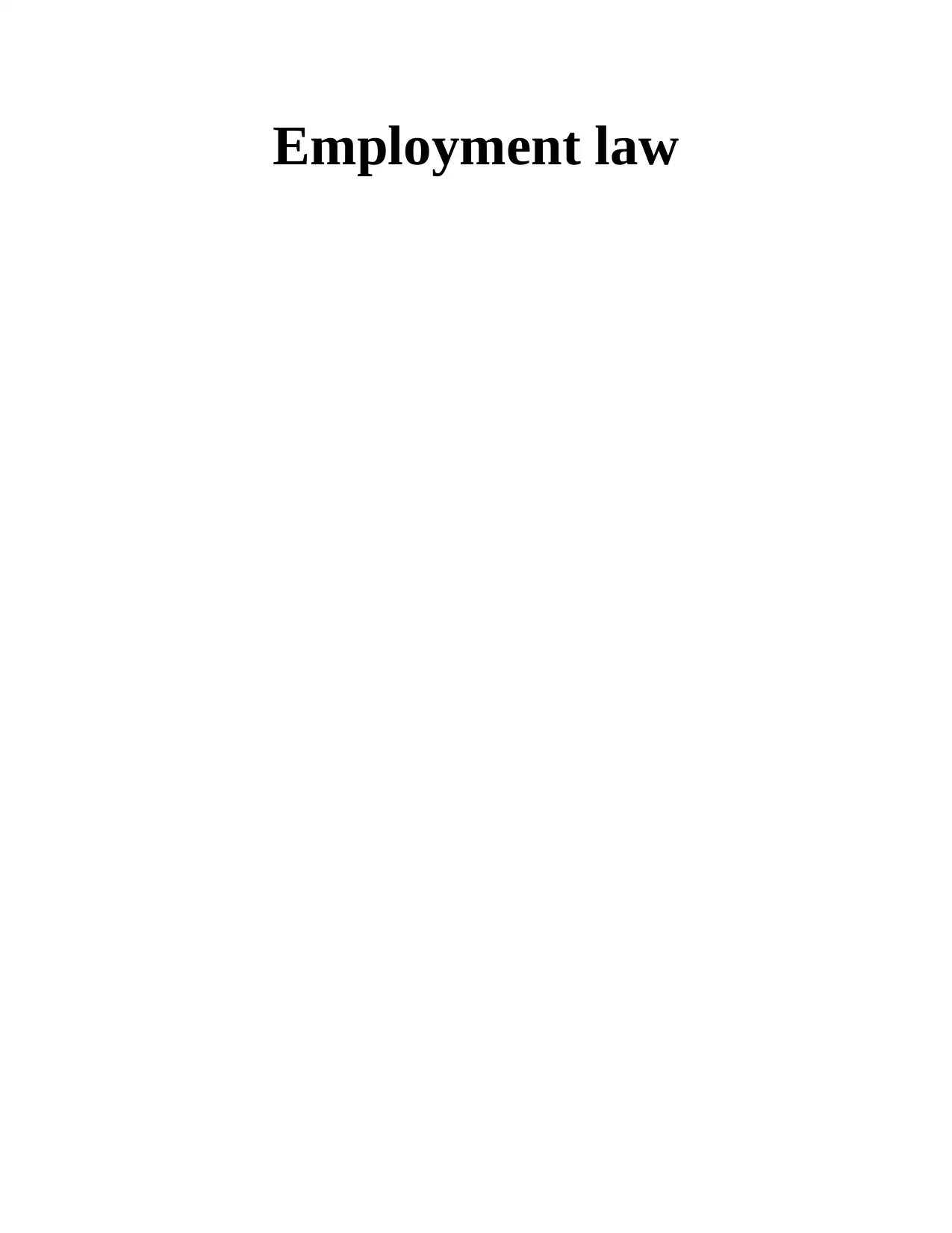
Employment law
Paraphrase This Document
Need a fresh take? Get an instant paraphrase of this document with our AI Paraphraser
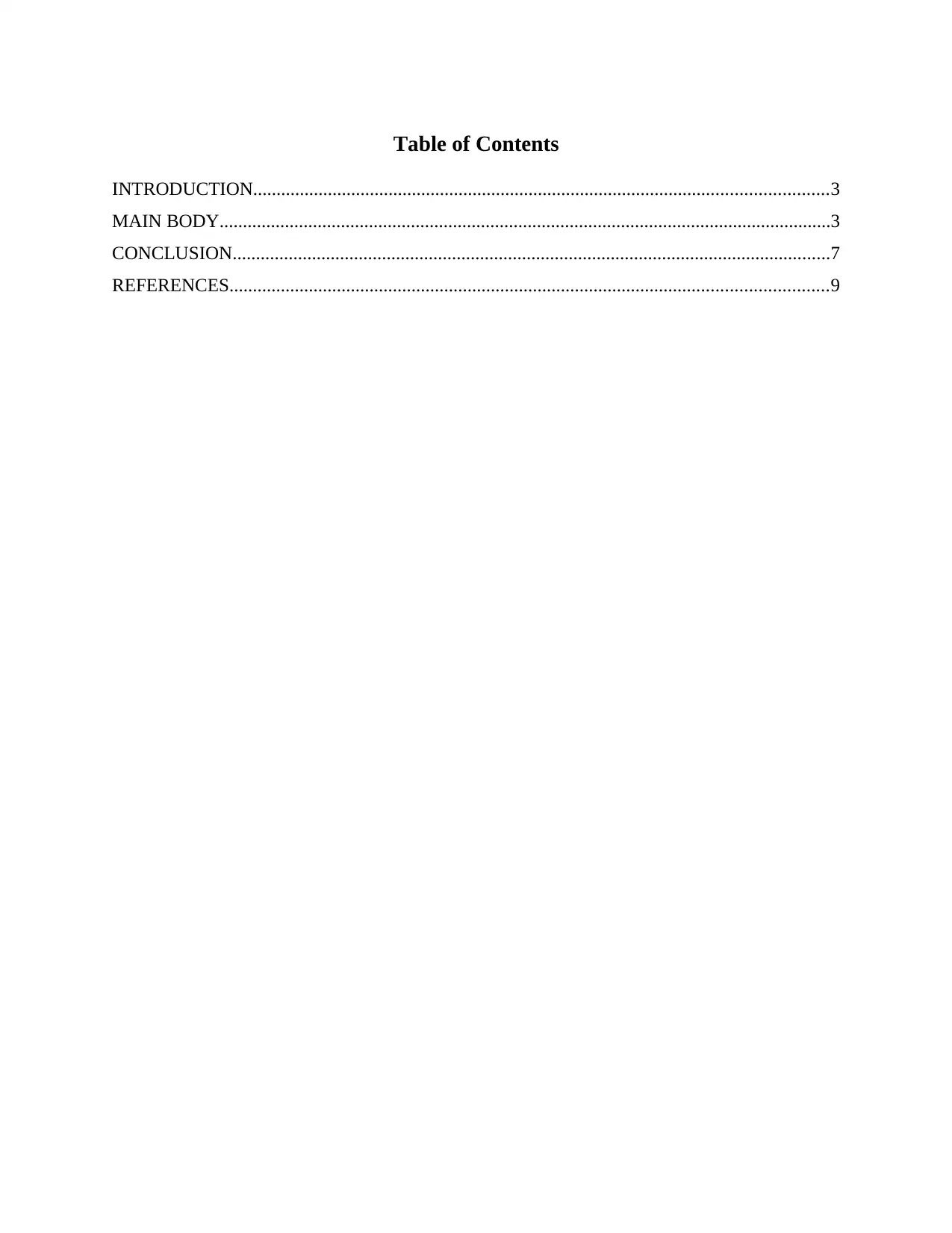
Table of Contents
INTRODUCTION...........................................................................................................................3
MAIN BODY...................................................................................................................................3
CONCLUSION................................................................................................................................7
REFERENCES................................................................................................................................9
INTRODUCTION...........................................................................................................................3
MAIN BODY...................................................................................................................................3
CONCLUSION................................................................................................................................7
REFERENCES................................................................................................................................9
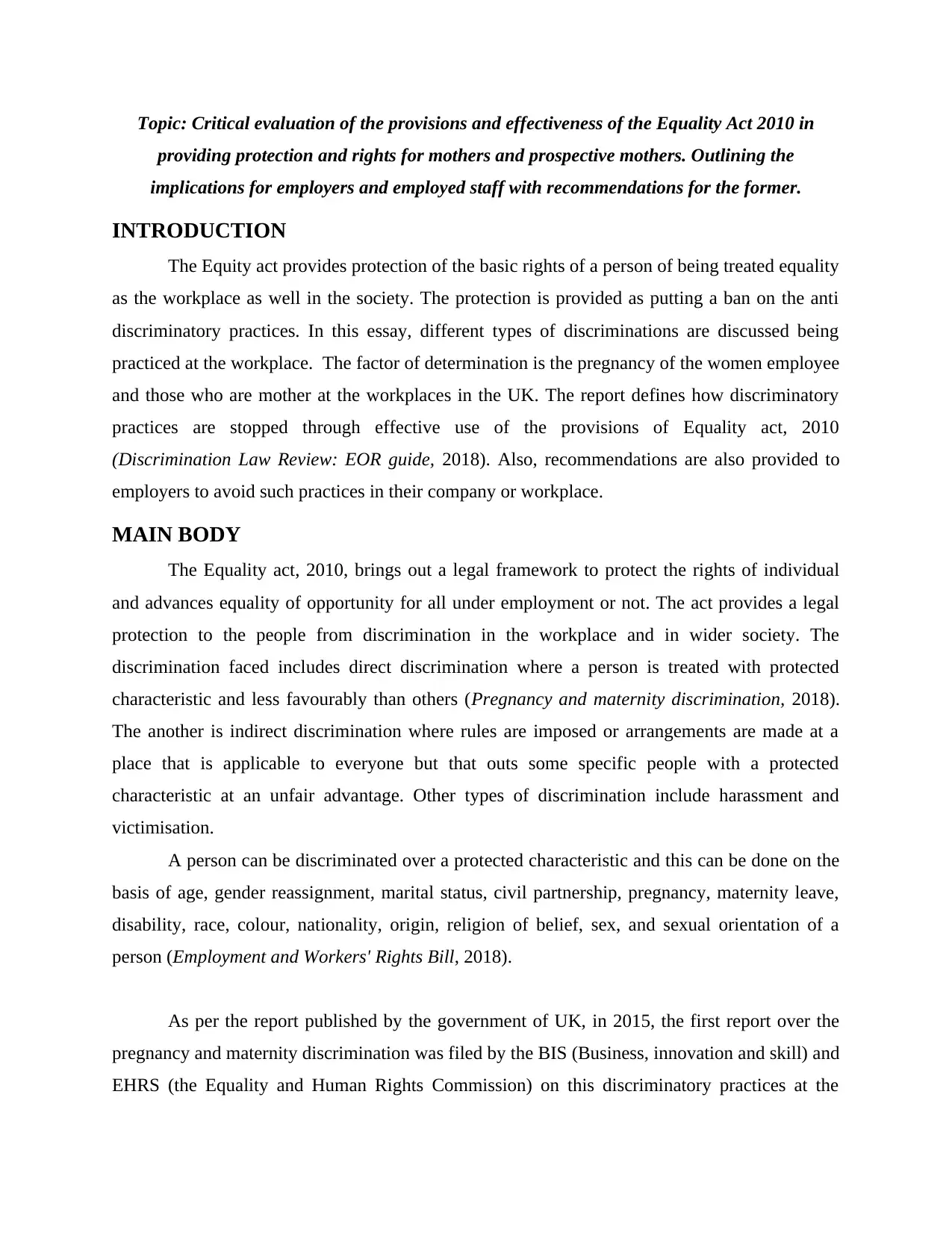
Topic: Critical evaluation of the provisions and effectiveness of the Equality Act 2010 in
providing protection and rights for mothers and prospective mothers. Outlining the
implications for employers and employed staff with recommendations for the former.
INTRODUCTION
The Equity act provides protection of the basic rights of a person of being treated equality
as the workplace as well in the society. The protection is provided as putting a ban on the anti
discriminatory practices. In this essay, different types of discriminations are discussed being
practiced at the workplace. The factor of determination is the pregnancy of the women employee
and those who are mother at the workplaces in the UK. The report defines how discriminatory
practices are stopped through effective use of the provisions of Equality act, 2010
(Discrimination Law Review: EOR guide, 2018). Also, recommendations are also provided to
employers to avoid such practices in their company or workplace.
MAIN BODY
The Equality act, 2010, brings out a legal framework to protect the rights of individual
and advances equality of opportunity for all under employment or not. The act provides a legal
protection to the people from discrimination in the workplace and in wider society. The
discrimination faced includes direct discrimination where a person is treated with protected
characteristic and less favourably than others (Pregnancy and maternity discrimination, 2018).
The another is indirect discrimination where rules are imposed or arrangements are made at a
place that is applicable to everyone but that outs some specific people with a protected
characteristic at an unfair advantage. Other types of discrimination include harassment and
victimisation.
A person can be discriminated over a protected characteristic and this can be done on the
basis of age, gender reassignment, marital status, civil partnership, pregnancy, maternity leave,
disability, race, colour, nationality, origin, religion of belief, sex, and sexual orientation of a
person (Employment and Workers' Rights Bill, 2018).
As per the report published by the government of UK, in 2015, the first report over the
pregnancy and maternity discrimination was filed by the BIS (Business, innovation and skill) and
EHRS (the Equality and Human Rights Commission) on this discriminatory practices at the
providing protection and rights for mothers and prospective mothers. Outlining the
implications for employers and employed staff with recommendations for the former.
INTRODUCTION
The Equity act provides protection of the basic rights of a person of being treated equality
as the workplace as well in the society. The protection is provided as putting a ban on the anti
discriminatory practices. In this essay, different types of discriminations are discussed being
practiced at the workplace. The factor of determination is the pregnancy of the women employee
and those who are mother at the workplaces in the UK. The report defines how discriminatory
practices are stopped through effective use of the provisions of Equality act, 2010
(Discrimination Law Review: EOR guide, 2018). Also, recommendations are also provided to
employers to avoid such practices in their company or workplace.
MAIN BODY
The Equality act, 2010, brings out a legal framework to protect the rights of individual
and advances equality of opportunity for all under employment or not. The act provides a legal
protection to the people from discrimination in the workplace and in wider society. The
discrimination faced includes direct discrimination where a person is treated with protected
characteristic and less favourably than others (Pregnancy and maternity discrimination, 2018).
The another is indirect discrimination where rules are imposed or arrangements are made at a
place that is applicable to everyone but that outs some specific people with a protected
characteristic at an unfair advantage. Other types of discrimination include harassment and
victimisation.
A person can be discriminated over a protected characteristic and this can be done on the
basis of age, gender reassignment, marital status, civil partnership, pregnancy, maternity leave,
disability, race, colour, nationality, origin, religion of belief, sex, and sexual orientation of a
person (Employment and Workers' Rights Bill, 2018).
As per the report published by the government of UK, in 2015, the first report over the
pregnancy and maternity discrimination was filed by the BIS (Business, innovation and skill) and
EHRS (the Equality and Human Rights Commission) on this discriminatory practices at the
⊘ This is a preview!⊘
Do you want full access?
Subscribe today to unlock all pages.

Trusted by 1+ million students worldwide
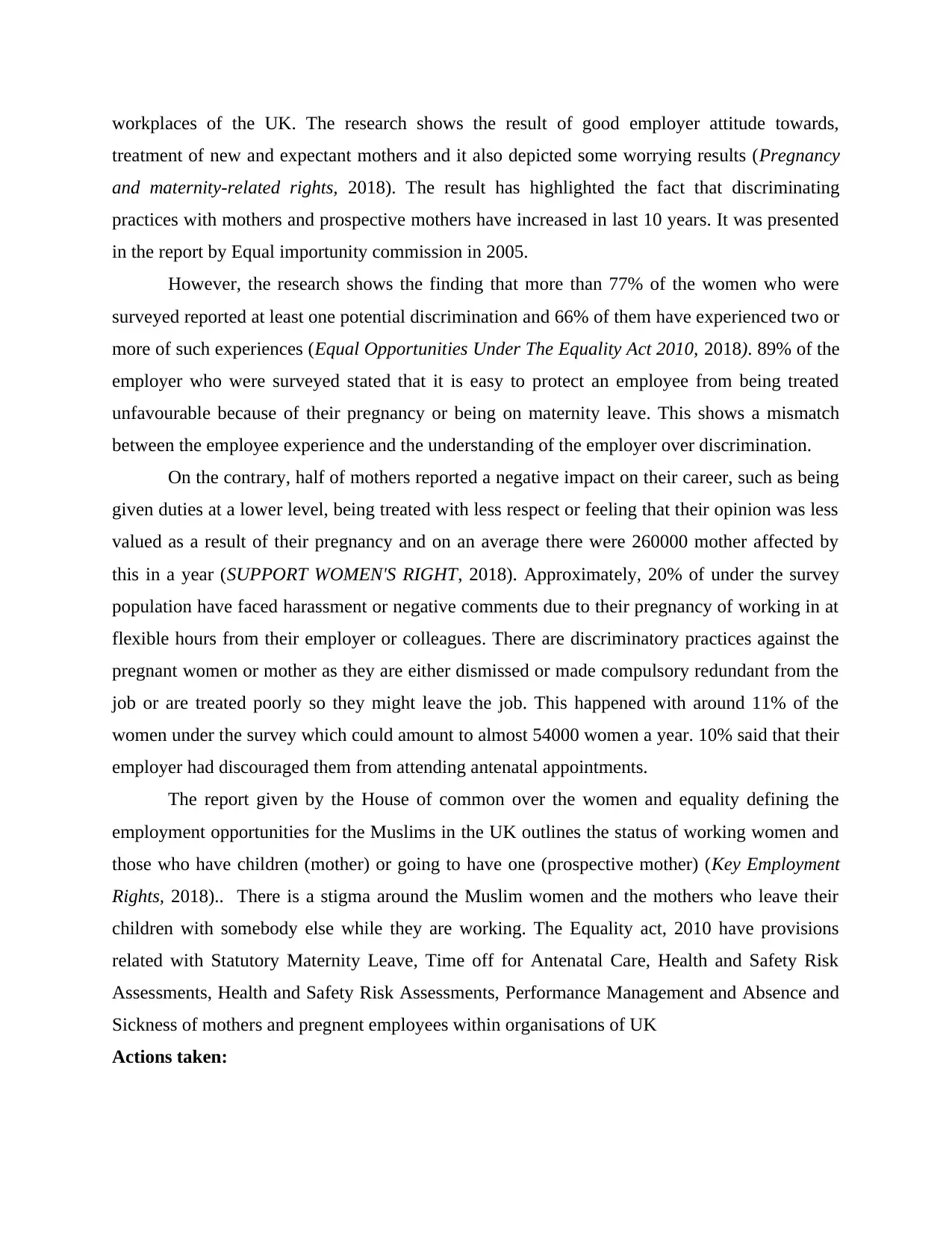
workplaces of the UK. The research shows the result of good employer attitude towards,
treatment of new and expectant mothers and it also depicted some worrying results (Pregnancy
and maternity-related rights, 2018). The result has highlighted the fact that discriminating
practices with mothers and prospective mothers have increased in last 10 years. It was presented
in the report by Equal importunity commission in 2005.
However, the research shows the finding that more than 77% of the women who were
surveyed reported at least one potential discrimination and 66% of them have experienced two or
more of such experiences (Equal Opportunities Under The Equality Act 2010, 2018). 89% of the
employer who were surveyed stated that it is easy to protect an employee from being treated
unfavourable because of their pregnancy or being on maternity leave. This shows a mismatch
between the employee experience and the understanding of the employer over discrimination.
On the contrary, half of mothers reported a negative impact on their career, such as being
given duties at a lower level, being treated with less respect or feeling that their opinion was less
valued as a result of their pregnancy and on an average there were 260000 mother affected by
this in a year (SUPPORT WOMEN'S RIGHT, 2018). Approximately, 20% of under the survey
population have faced harassment or negative comments due to their pregnancy of working in at
flexible hours from their employer or colleagues. There are discriminatory practices against the
pregnant women or mother as they are either dismissed or made compulsory redundant from the
job or are treated poorly so they might leave the job. This happened with around 11% of the
women under the survey which could amount to almost 54000 women a year. 10% said that their
employer had discouraged them from attending antenatal appointments.
The report given by the House of common over the women and equality defining the
employment opportunities for the Muslims in the UK outlines the status of working women and
those who have children (mother) or going to have one (prospective mother) (Key Employment
Rights, 2018).. There is a stigma around the Muslim women and the mothers who leave their
children with somebody else while they are working. The Equality act, 2010 have provisions
related with Statutory Maternity Leave, Time off for Antenatal Care, Health and Safety Risk
Assessments, Health and Safety Risk Assessments, Performance Management and Absence and
Sickness of mothers and pregnent employees within organisations of UK
Actions taken:
treatment of new and expectant mothers and it also depicted some worrying results (Pregnancy
and maternity-related rights, 2018). The result has highlighted the fact that discriminating
practices with mothers and prospective mothers have increased in last 10 years. It was presented
in the report by Equal importunity commission in 2005.
However, the research shows the finding that more than 77% of the women who were
surveyed reported at least one potential discrimination and 66% of them have experienced two or
more of such experiences (Equal Opportunities Under The Equality Act 2010, 2018). 89% of the
employer who were surveyed stated that it is easy to protect an employee from being treated
unfavourable because of their pregnancy or being on maternity leave. This shows a mismatch
between the employee experience and the understanding of the employer over discrimination.
On the contrary, half of mothers reported a negative impact on their career, such as being
given duties at a lower level, being treated with less respect or feeling that their opinion was less
valued as a result of their pregnancy and on an average there were 260000 mother affected by
this in a year (SUPPORT WOMEN'S RIGHT, 2018). Approximately, 20% of under the survey
population have faced harassment or negative comments due to their pregnancy of working in at
flexible hours from their employer or colleagues. There are discriminatory practices against the
pregnant women or mother as they are either dismissed or made compulsory redundant from the
job or are treated poorly so they might leave the job. This happened with around 11% of the
women under the survey which could amount to almost 54000 women a year. 10% said that their
employer had discouraged them from attending antenatal appointments.
The report given by the House of common over the women and equality defining the
employment opportunities for the Muslims in the UK outlines the status of working women and
those who have children (mother) or going to have one (prospective mother) (Key Employment
Rights, 2018).. There is a stigma around the Muslim women and the mothers who leave their
children with somebody else while they are working. The Equality act, 2010 have provisions
related with Statutory Maternity Leave, Time off for Antenatal Care, Health and Safety Risk
Assessments, Health and Safety Risk Assessments, Performance Management and Absence and
Sickness of mothers and pregnent employees within organisations of UK
Actions taken:
Paraphrase This Document
Need a fresh take? Get an instant paraphrase of this document with our AI Paraphraser
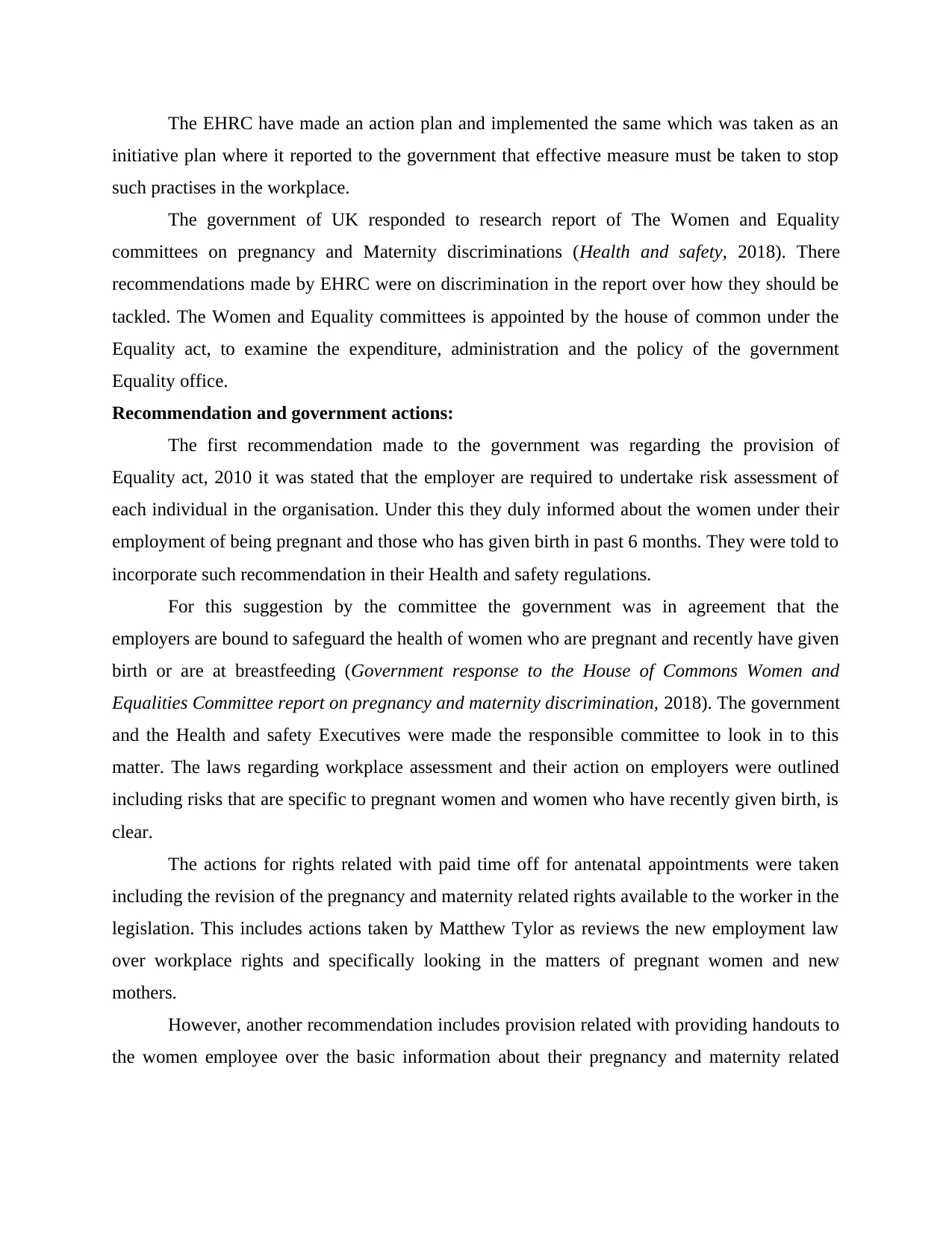
The EHRC have made an action plan and implemented the same which was taken as an
initiative plan where it reported to the government that effective measure must be taken to stop
such practises in the workplace.
The government of UK responded to research report of The Women and Equality
committees on pregnancy and Maternity discriminations (Health and safety, 2018). There
recommendations made by EHRC were on discrimination in the report over how they should be
tackled. The Women and Equality committees is appointed by the house of common under the
Equality act, to examine the expenditure, administration and the policy of the government
Equality office.
Recommendation and government actions:
The first recommendation made to the government was regarding the provision of
Equality act, 2010 it was stated that the employer are required to undertake risk assessment of
each individual in the organisation. Under this they duly informed about the women under their
employment of being pregnant and those who has given birth in past 6 months. They were told to
incorporate such recommendation in their Health and safety regulations.
For this suggestion by the committee the government was in agreement that the
employers are bound to safeguard the health of women who are pregnant and recently have given
birth or are at breastfeeding (Government response to the House of Commons Women and
Equalities Committee report on pregnancy and maternity discrimination, 2018). The government
and the Health and safety Executives were made the responsible committee to look in to this
matter. The laws regarding workplace assessment and their action on employers were outlined
including risks that are specific to pregnant women and women who have recently given birth, is
clear.
The actions for rights related with paid time off for antenatal appointments were taken
including the revision of the pregnancy and maternity related rights available to the worker in the
legislation. This includes actions taken by Matthew Tylor as reviews the new employment law
over workplace rights and specifically looking in the matters of pregnant women and new
mothers.
However, another recommendation includes provision related with providing handouts to
the women employee over the basic information about their pregnancy and maternity related
initiative plan where it reported to the government that effective measure must be taken to stop
such practises in the workplace.
The government of UK responded to research report of The Women and Equality
committees on pregnancy and Maternity discriminations (Health and safety, 2018). There
recommendations made by EHRC were on discrimination in the report over how they should be
tackled. The Women and Equality committees is appointed by the house of common under the
Equality act, to examine the expenditure, administration and the policy of the government
Equality office.
Recommendation and government actions:
The first recommendation made to the government was regarding the provision of
Equality act, 2010 it was stated that the employer are required to undertake risk assessment of
each individual in the organisation. Under this they duly informed about the women under their
employment of being pregnant and those who has given birth in past 6 months. They were told to
incorporate such recommendation in their Health and safety regulations.
For this suggestion by the committee the government was in agreement that the
employers are bound to safeguard the health of women who are pregnant and recently have given
birth or are at breastfeeding (Government response to the House of Commons Women and
Equalities Committee report on pregnancy and maternity discrimination, 2018). The government
and the Health and safety Executives were made the responsible committee to look in to this
matter. The laws regarding workplace assessment and their action on employers were outlined
including risks that are specific to pregnant women and women who have recently given birth, is
clear.
The actions for rights related with paid time off for antenatal appointments were taken
including the revision of the pregnancy and maternity related rights available to the worker in the
legislation. This includes actions taken by Matthew Tylor as reviews the new employment law
over workplace rights and specifically looking in the matters of pregnant women and new
mothers.
However, another recommendation includes provision related with providing handouts to
the women employee over the basic information about their pregnancy and maternity related

employment rights (EHRC recommendations and Government response, 2018). It must state the
responsibilities of the employer and includes signpost, address and employee information.
Over this the response of the government was with an unanimous and it took an action
with the select committee that pregnant women and new motherer under the employment shall be
provide with basic information over their pregnancy and related rights for this particular time
period.
Moreover, Maternity Transformation Program was launched in July 2016 in UK with
partnership off Better births and a digital maternity tool was developed to being together the best
digital services and online information from NHS and other organisations including the
maternity and related employment rights (Discrimination: your rights, 2018). This tool uses a
combination of videos, emails and social media to assess the need and requirement of pregnant
women and new mothers under the employment.
In this context the Start4life Information service for parents was lanced which provides
digital services enabling the would be parents and new parents as well, receiving emails, videos
and SMS on regular basis providing them high end information about the child and mother on
the stages of pregnancy and age of the child.
Furthermore, the Royal college Midwives developed a guidance note for the midwives as
Pregnancy and Maternity rights at work. This provided information to the midwives over the
maternity employment rights and the access to them for future help to women under employment
in case they are experience any kind of pregnancy discrimination at workplaces (Discrimination
at work, 2018). The Government is working with the EHRC, Acas and organisations
representing employers and employees to understand better the needs of users of maternity
related employment information, so that we can ensure that they are able to access accurate, up-
to-date information quickly and easily.
Implication for employers:
Discriminatory practices at the workplace are not a god sign of a heath and good
workplace culture. The employer is responsible to avoid such practices in the workplace. The
employer if found guilty of an intentional act of discrimination or practice that have
discrimination effect, the employer may be entitled to pay employment discrimination damages.
Implication for Employed staff:
responsibilities of the employer and includes signpost, address and employee information.
Over this the response of the government was with an unanimous and it took an action
with the select committee that pregnant women and new motherer under the employment shall be
provide with basic information over their pregnancy and related rights for this particular time
period.
Moreover, Maternity Transformation Program was launched in July 2016 in UK with
partnership off Better births and a digital maternity tool was developed to being together the best
digital services and online information from NHS and other organisations including the
maternity and related employment rights (Discrimination: your rights, 2018). This tool uses a
combination of videos, emails and social media to assess the need and requirement of pregnant
women and new mothers under the employment.
In this context the Start4life Information service for parents was lanced which provides
digital services enabling the would be parents and new parents as well, receiving emails, videos
and SMS on regular basis providing them high end information about the child and mother on
the stages of pregnancy and age of the child.
Furthermore, the Royal college Midwives developed a guidance note for the midwives as
Pregnancy and Maternity rights at work. This provided information to the midwives over the
maternity employment rights and the access to them for future help to women under employment
in case they are experience any kind of pregnancy discrimination at workplaces (Discrimination
at work, 2018). The Government is working with the EHRC, Acas and organisations
representing employers and employees to understand better the needs of users of maternity
related employment information, so that we can ensure that they are able to access accurate, up-
to-date information quickly and easily.
Implication for employers:
Discriminatory practices at the workplace are not a god sign of a heath and good
workplace culture. The employer is responsible to avoid such practices in the workplace. The
employer if found guilty of an intentional act of discrimination or practice that have
discrimination effect, the employer may be entitled to pay employment discrimination damages.
Implication for Employed staff:
⊘ This is a preview!⊘
Do you want full access?
Subscribe today to unlock all pages.

Trusted by 1+ million students worldwide
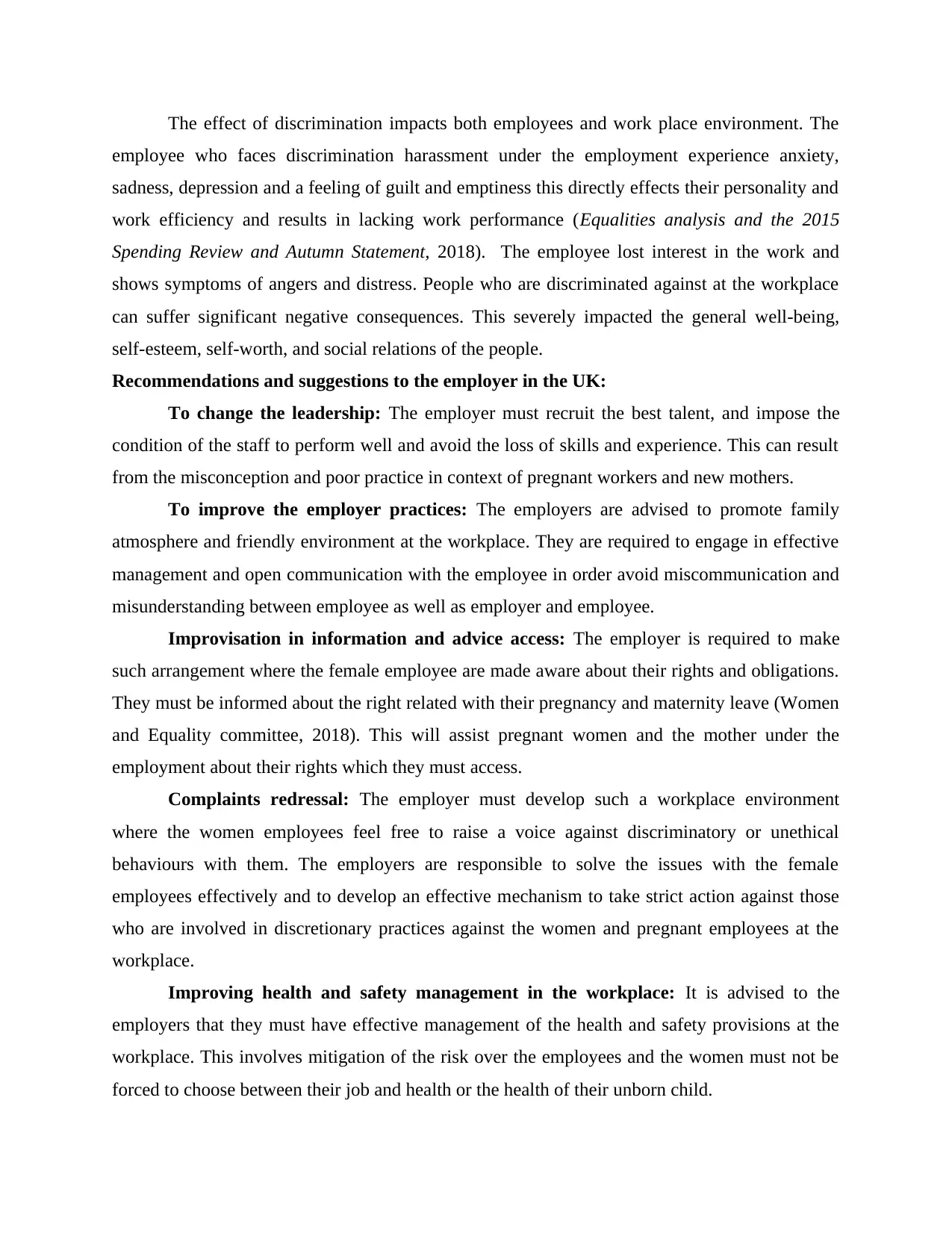
The effect of discrimination impacts both employees and work place environment. The
employee who faces discrimination harassment under the employment experience anxiety,
sadness, depression and a feeling of guilt and emptiness this directly effects their personality and
work efficiency and results in lacking work performance (Equalities analysis and the 2015
Spending Review and Autumn Statement, 2018). The employee lost interest in the work and
shows symptoms of angers and distress. People who are discriminated against at the workplace
can suffer significant negative consequences. This severely impacted the general well-being,
self-esteem, self-worth, and social relations of the people.
Recommendations and suggestions to the employer in the UK:
To change the leadership: The employer must recruit the best talent, and impose the
condition of the staff to perform well and avoid the loss of skills and experience. This can result
from the misconception and poor practice in context of pregnant workers and new mothers.
To improve the employer practices: The employers are advised to promote family
atmosphere and friendly environment at the workplace. They are required to engage in effective
management and open communication with the employee in order avoid miscommunication and
misunderstanding between employee as well as employer and employee.
Improvisation in information and advice access: The employer is required to make
such arrangement where the female employee are made aware about their rights and obligations.
They must be informed about the right related with their pregnancy and maternity leave (Women
and Equality committee, 2018). This will assist pregnant women and the mother under the
employment about their rights which they must access.
Complaints redressal: The employer must develop such a workplace environment
where the women employees feel free to raise a voice against discriminatory or unethical
behaviours with them. The employers are responsible to solve the issues with the female
employees effectively and to develop an effective mechanism to take strict action against those
who are involved in discretionary practices against the women and pregnant employees at the
workplace.
Improving health and safety management in the workplace: It is advised to the
employers that they must have effective management of the health and safety provisions at the
workplace. This involves mitigation of the risk over the employees and the women must not be
forced to choose between their job and health or the health of their unborn child.
employee who faces discrimination harassment under the employment experience anxiety,
sadness, depression and a feeling of guilt and emptiness this directly effects their personality and
work efficiency and results in lacking work performance (Equalities analysis and the 2015
Spending Review and Autumn Statement, 2018). The employee lost interest in the work and
shows symptoms of angers and distress. People who are discriminated against at the workplace
can suffer significant negative consequences. This severely impacted the general well-being,
self-esteem, self-worth, and social relations of the people.
Recommendations and suggestions to the employer in the UK:
To change the leadership: The employer must recruit the best talent, and impose the
condition of the staff to perform well and avoid the loss of skills and experience. This can result
from the misconception and poor practice in context of pregnant workers and new mothers.
To improve the employer practices: The employers are advised to promote family
atmosphere and friendly environment at the workplace. They are required to engage in effective
management and open communication with the employee in order avoid miscommunication and
misunderstanding between employee as well as employer and employee.
Improvisation in information and advice access: The employer is required to make
such arrangement where the female employee are made aware about their rights and obligations.
They must be informed about the right related with their pregnancy and maternity leave (Women
and Equality committee, 2018). This will assist pregnant women and the mother under the
employment about their rights which they must access.
Complaints redressal: The employer must develop such a workplace environment
where the women employees feel free to raise a voice against discriminatory or unethical
behaviours with them. The employers are responsible to solve the issues with the female
employees effectively and to develop an effective mechanism to take strict action against those
who are involved in discretionary practices against the women and pregnant employees at the
workplace.
Improving health and safety management in the workplace: It is advised to the
employers that they must have effective management of the health and safety provisions at the
workplace. This involves mitigation of the risk over the employees and the women must not be
forced to choose between their job and health or the health of their unborn child.
Paraphrase This Document
Need a fresh take? Get an instant paraphrase of this document with our AI Paraphraser
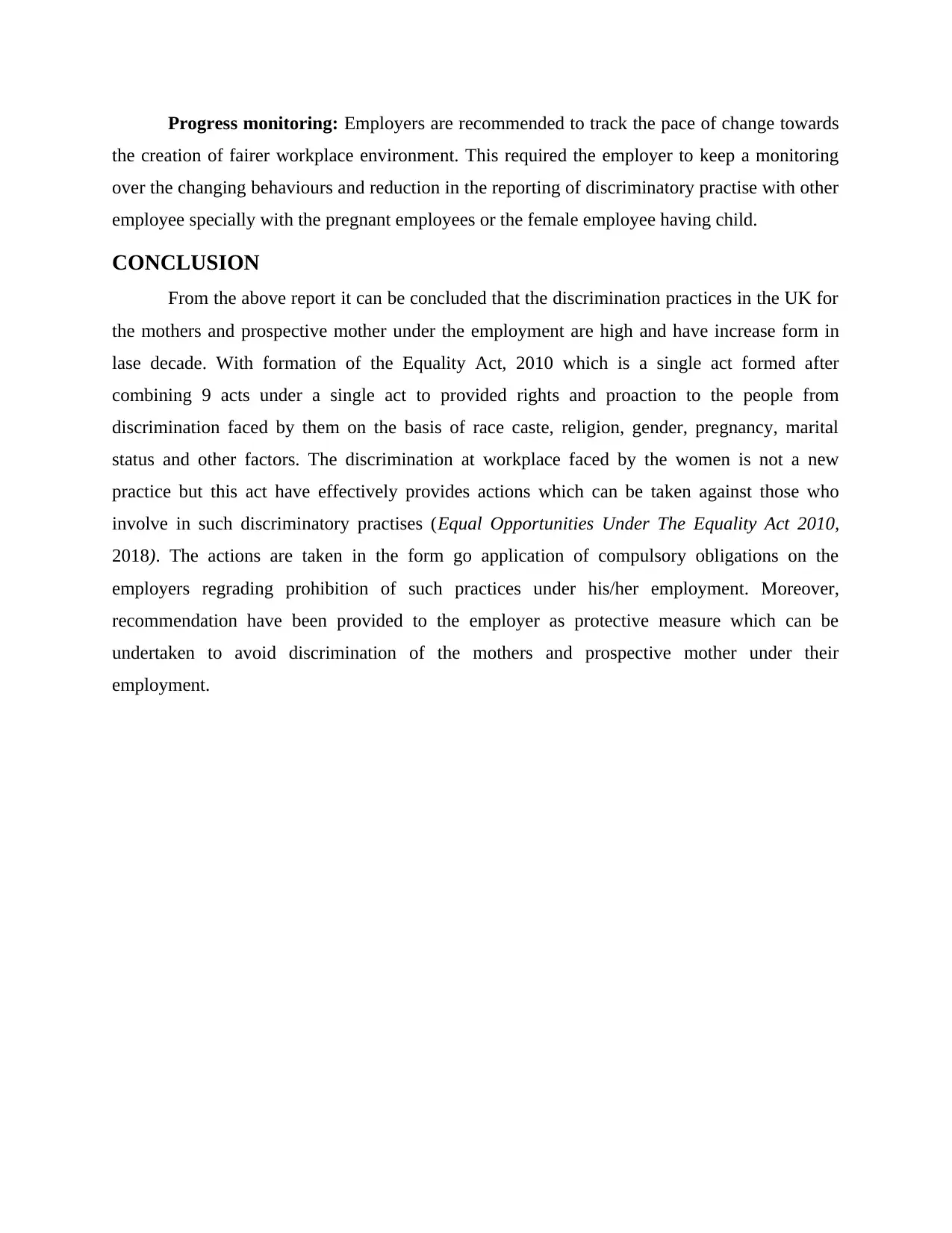
Progress monitoring: Employers are recommended to track the pace of change towards
the creation of fairer workplace environment. This required the employer to keep a monitoring
over the changing behaviours and reduction in the reporting of discriminatory practise with other
employee specially with the pregnant employees or the female employee having child.
CONCLUSION
From the above report it can be concluded that the discrimination practices in the UK for
the mothers and prospective mother under the employment are high and have increase form in
lase decade. With formation of the Equality Act, 2010 which is a single act formed after
combining 9 acts under a single act to provided rights and proaction to the people from
discrimination faced by them on the basis of race caste, religion, gender, pregnancy, marital
status and other factors. The discrimination at workplace faced by the women is not a new
practice but this act have effectively provides actions which can be taken against those who
involve in such discriminatory practises (Equal Opportunities Under The Equality Act 2010,
2018). The actions are taken in the form go application of compulsory obligations on the
employers regrading prohibition of such practices under his/her employment. Moreover,
recommendation have been provided to the employer as protective measure which can be
undertaken to avoid discrimination of the mothers and prospective mother under their
employment.
the creation of fairer workplace environment. This required the employer to keep a monitoring
over the changing behaviours and reduction in the reporting of discriminatory practise with other
employee specially with the pregnant employees or the female employee having child.
CONCLUSION
From the above report it can be concluded that the discrimination practices in the UK for
the mothers and prospective mother under the employment are high and have increase form in
lase decade. With formation of the Equality Act, 2010 which is a single act formed after
combining 9 acts under a single act to provided rights and proaction to the people from
discrimination faced by them on the basis of race caste, religion, gender, pregnancy, marital
status and other factors. The discrimination at workplace faced by the women is not a new
practice but this act have effectively provides actions which can be taken against those who
involve in such discriminatory practises (Equal Opportunities Under The Equality Act 2010,
2018). The actions are taken in the form go application of compulsory obligations on the
employers regrading prohibition of such practices under his/her employment. Moreover,
recommendation have been provided to the employer as protective measure which can be
undertaken to avoid discrimination of the mothers and prospective mother under their
employment.
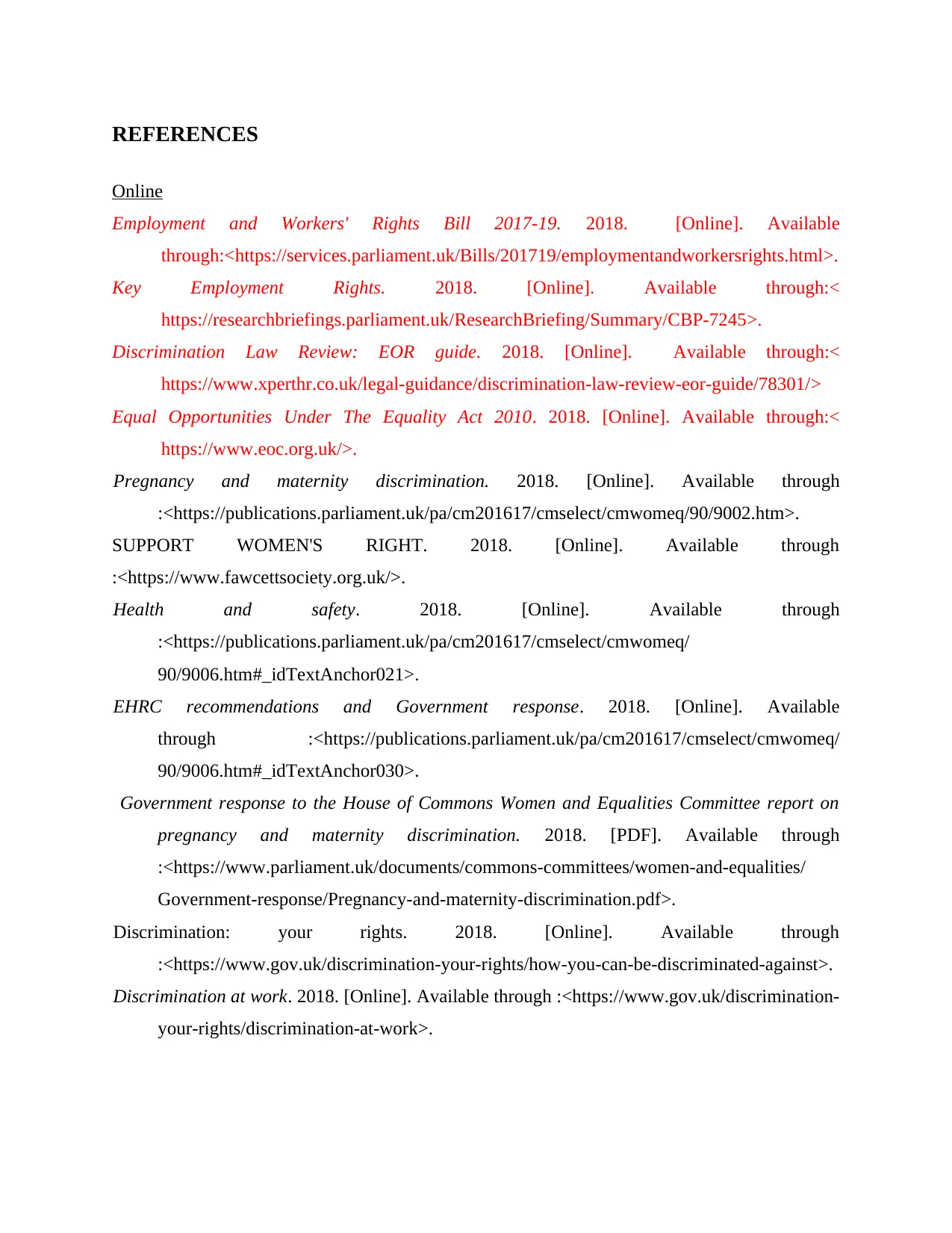
REFERENCES
Online
Employment and Workers' Rights Bill 2017-19. 2018. [Online]. Available
through:<https://services.parliament.uk/Bills/201719/employmentandworkersrights.html>.
Key Employment Rights. 2018. [Online]. Available through:<
https://researchbriefings.parliament.uk/ResearchBriefing/Summary/CBP-7245>.
Discrimination Law Review: EOR guide. 2018. [Online]. Available through:<
https://www.xperthr.co.uk/legal-guidance/discrimination-law-review-eor-guide/78301/>
Equal Opportunities Under The Equality Act 2010. 2018. [Online]. Available through:<
https://www.eoc.org.uk/>.
Pregnancy and maternity discrimination. 2018. [Online]. Available through
:<https://publications.parliament.uk/pa/cm201617/cmselect/cmwomeq/90/9002.htm>.
SUPPORT WOMEN'S RIGHT. 2018. [Online]. Available through
:<https://www.fawcettsociety.org.uk/>.
Health and safety. 2018. [Online]. Available through
:<https://publications.parliament.uk/pa/cm201617/cmselect/cmwomeq/
90/9006.htm#_idTextAnchor021>.
EHRC recommendations and Government response. 2018. [Online]. Available
through :<https://publications.parliament.uk/pa/cm201617/cmselect/cmwomeq/
90/9006.htm#_idTextAnchor030>.
Government response to the House of Commons Women and Equalities Committee report on
pregnancy and maternity discrimination. 2018. [PDF]. Available through
:<https://www.parliament.uk/documents/commons-committees/women-and-equalities/
Government-response/Pregnancy-and-maternity-discrimination.pdf>.
Discrimination: your rights. 2018. [Online]. Available through
:<https://www.gov.uk/discrimination-your-rights/how-you-can-be-discriminated-against>.
Discrimination at work. 2018. [Online]. Available through :<https://www.gov.uk/discrimination-
your-rights/discrimination-at-work>.
Online
Employment and Workers' Rights Bill 2017-19. 2018. [Online]. Available
through:<https://services.parliament.uk/Bills/201719/employmentandworkersrights.html>.
Key Employment Rights. 2018. [Online]. Available through:<
https://researchbriefings.parliament.uk/ResearchBriefing/Summary/CBP-7245>.
Discrimination Law Review: EOR guide. 2018. [Online]. Available through:<
https://www.xperthr.co.uk/legal-guidance/discrimination-law-review-eor-guide/78301/>
Equal Opportunities Under The Equality Act 2010. 2018. [Online]. Available through:<
https://www.eoc.org.uk/>.
Pregnancy and maternity discrimination. 2018. [Online]. Available through
:<https://publications.parliament.uk/pa/cm201617/cmselect/cmwomeq/90/9002.htm>.
SUPPORT WOMEN'S RIGHT. 2018. [Online]. Available through
:<https://www.fawcettsociety.org.uk/>.
Health and safety. 2018. [Online]. Available through
:<https://publications.parliament.uk/pa/cm201617/cmselect/cmwomeq/
90/9006.htm#_idTextAnchor021>.
EHRC recommendations and Government response. 2018. [Online]. Available
through :<https://publications.parliament.uk/pa/cm201617/cmselect/cmwomeq/
90/9006.htm#_idTextAnchor030>.
Government response to the House of Commons Women and Equalities Committee report on
pregnancy and maternity discrimination. 2018. [PDF]. Available through
:<https://www.parliament.uk/documents/commons-committees/women-and-equalities/
Government-response/Pregnancy-and-maternity-discrimination.pdf>.
Discrimination: your rights. 2018. [Online]. Available through
:<https://www.gov.uk/discrimination-your-rights/how-you-can-be-discriminated-against>.
Discrimination at work. 2018. [Online]. Available through :<https://www.gov.uk/discrimination-
your-rights/discrimination-at-work>.
⊘ This is a preview!⊘
Do you want full access?
Subscribe today to unlock all pages.

Trusted by 1+ million students worldwide
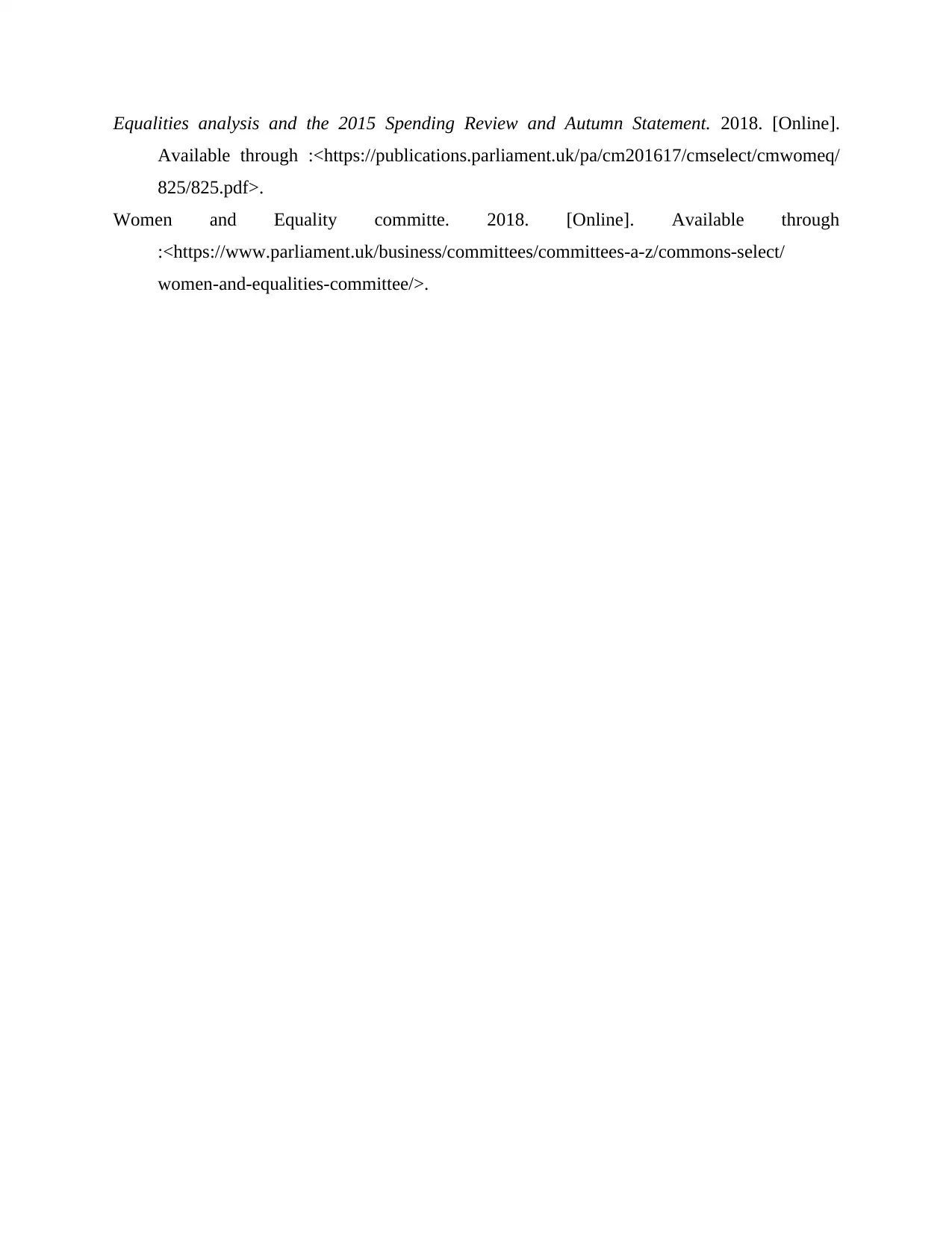
Equalities analysis and the 2015 Spending Review and Autumn Statement. 2018. [Online].
Available through :<https://publications.parliament.uk/pa/cm201617/cmselect/cmwomeq/
825/825.pdf>.
Women and Equality committe. 2018. [Online]. Available through
:<https://www.parliament.uk/business/committees/committees-a-z/commons-select/
women-and-equalities-committee/>.
Available through :<https://publications.parliament.uk/pa/cm201617/cmselect/cmwomeq/
825/825.pdf>.
Women and Equality committe. 2018. [Online]. Available through
:<https://www.parliament.uk/business/committees/committees-a-z/commons-select/
women-and-equalities-committee/>.
Paraphrase This Document
Need a fresh take? Get an instant paraphrase of this document with our AI Paraphraser

1 out of 11
Related Documents
Your All-in-One AI-Powered Toolkit for Academic Success.
+13062052269
info@desklib.com
Available 24*7 on WhatsApp / Email
![[object Object]](/_next/static/media/star-bottom.7253800d.svg)
Unlock your academic potential
Copyright © 2020–2026 A2Z Services. All Rights Reserved. Developed and managed by ZUCOL.





